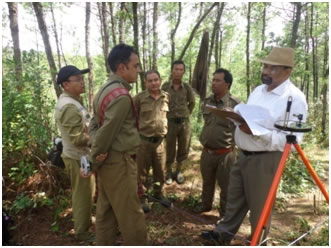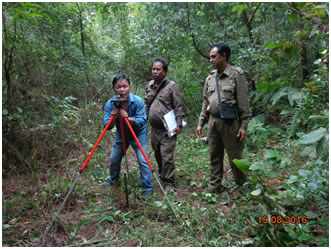- Skip to main content
- Screen Access Reader
- Text Size



- Contrast Options


- Character Spacing

Working Plan Division
1. Activities
i) Prescription, Revision etc of the Working Plan for all Reserved Forests and Protected Forests under the control of the State Government as per the National Working Plan Code, 2014
ii) Preparation and prescription of a Working Schemes of the private/ community forests of the State under the control of Autonomous District Councils of Khasi, Jaintia and Garo Hills.
iii) To survey and demarcate of RFs and PFs boundaries from time to time including compartment demarcation for better management by concerned Territorial Division.
iv) To carry out all types of Forest survey and inventory works in the state as and when entrusted for the better management of forest and its resources.
2. Achievements
i) Preparation of Working Plan: - The Working Plans were prepared for the Reserve Forest and Protected Forest of the following region of the state as follows:-
a) The Working Plan of The Reserve Forests of Jaintia Hills Division:- This Working Plan was prepared for the three Reserve Forest of Jaintia Hills Division namely Narpuh Block-I RF, Narpuh Block-II RF and Saipung RF. The Working Plan was approved for a period of 10 years w.e.f. 2013-2014 upto 2022-2023 by the Ministry of Environment and Forests & Climate Change, North East Regional Office, Shillong on the 20th August 2013 vide Letter No.12-6-61/2013/ RONE/WP/RF Jaintia Hills/ML/2086-89 dated 20th August 2013.
During Mid-term revision of the Approved Working Plan initiated in July 2018, the area of Narpuh Block-II, RF will be reduced consequent upon the notification of 59.90 sq.kms. of this Reserve as Narpuh Wildlife sanctuary vide No. FOR.128/2013/20 dated 10th June, 2014.
b) The Working Plan of The Reserve/Protected Forests of In and Around Shillong under Khasi Hills Division:- This Working Plan was prepared for the two Reserve Forest and Four Protected Forest under Khasi Hills Territorial Division namely Raitkhwan RF, Shyrwat RF, Short round PF, Umkhuti PF, Laitkor PF, Laban PF and
c) The Working Plan of Nongkhyllem and Umsaw Reserve Forest under Khasi Hills Division: - This Working Plan was prepared for the two Reserve Forest under Khasi Hills Territorial Division namely Nongkhyllem RF and Umsaw RF. The Working Plan was approved for a period of 10 years w.e.f. 2013-2014 upto 2022-2023 by the Ministry of Environment and Forests & Climate Change, North East Regionl Office, Shillong on the 26th August 2013 vide Letter No.12-1-60/2013/ RONE/WP/RF-Umsaw/SHG/ML/2191-94 dated 26th August 2013.
d) The Working Plan of The Reserve Forest under Garo Hills Division:- This Working Plan was prepared for the Sixteen Reserve Forest under Garo Hills Territorial Division namely Angrartoli RF, Chimabangshi RF, Dhima RF, Dambu RF, Songsak RF, Darugiri RF, Dilma RF, Ildex RF, Rajasimla RF,Rongrengiri RF, Baghmara RF, Emangiri RF, Rewak RF, Gittingiri RF, Tura Peak RF and Dibru Hills RF. The Working Plan was approved for a period from the year 2013-2014 upto 2022-2023 by the Ministry of Environment and Forests & Climate Change, North East Regional Office, Shillong on the 03rd October 2013 vide Letter No.12-1-58/2013/ RONE/WP/RF/Garo Hills/ML/2863-66 dated 03rd October 2013.
Mid-term review of the Approved Working Plan was initiated in July 2018 and with the bifurcation of Garo Hills Division into two Divisions i.e. West, South and South West Garo Hills Division, Tura and East and North Garo Hills Division Williamnagar, these Approved Working Plan also has been reviewed as Working Plan for West, South and South West Garo Hills Division, Tura and Working Plan for East and North Garo Hills Division Williamnagar. This revision is targeted to complete in December 2018.
ii) Preparation and Implementation of Working Schemes:- As per the Hon’ble Supreme Court order in Writ Petition (Civil) 202/95 dated 15.01.1998 for the scientific management of forest Working Schemes is to be prepared. Accordingly, two Working Scheme for the private/ community forests under the jurisdiction of Jaintia Hills Autonomous District Council (JHADC) has been prepared and approved for the period 2006-11 and 2012-17. Currently, the Working Scheme for the 32 numbers private/ community forests under Thadlaskein Community and Rural (C&RD) Block under JHADC for the period 2017-22 for an area of 521.87 ha has been prepared and approved by the Ministry of Environment and Forests & Climate Change, North East Regional Office, Shillong on the 21st November 2017 vide Letter No.12-8-72/2010/WP-WS (ML)/RONE/2320-24 for a period of 5 Years w.e.f. December 2017 up to November 2022.
More Working Schemes is contemplated to be prepared for the private/community forests under the jurisdiction of Khasi, Jaintia and Garo Hills Autonomous District Councils.
iii) Preparation of Comprehensive forestry Inventory of Khasi Hills Region, 2015-16.
 Scheme “Comprehensive Forest Resource Inventory of Khasi Hills Region using RS-GIS based methodology of Stratified Random Sampling in the four districts namely East Khasi Hills, South West Khasi Hills, West Khasi Hills and Ri Bhoi District” under Compensatory Afforestation Management and Planning Authority (CAMPA) were implemented during the year 2015-17 and the final report of the inventory was published subsequently. A total of 2997 sample plots were surveyed and enumerated in the entire four districts using RS-GIS based Methodology of Stratified Random Sampling.
Scheme “Comprehensive Forest Resource Inventory of Khasi Hills Region using RS-GIS based methodology of Stratified Random Sampling in the four districts namely East Khasi Hills, South West Khasi Hills, West Khasi Hills and Ri Bhoi District” under Compensatory Afforestation Management and Planning Authority (CAMPA) were implemented during the year 2015-17 and the final report of the inventory was published subsequently. A total of 2997 sample plots were surveyed and enumerated in the entire four districts using RS-GIS based Methodology of Stratified Random Sampling.
A brief summary of the output of the scheme is as highlighted below:
Analysis shows that the largest numbers of trees are found as miscellaneous species in all the four districts. Among the five dominant species, Pinus kesiya has the largest number of trees in East Khasi Hills followed by Schima wallichii, Castonopsis species, Betula alnoides and Macaranga denticulate. In West Khasi Hills, Pinus kesiya has the largest number of trees followed by Schima wallichii , Castonopsis species, Macaranga denticulate and Betula alnoides. In South West Khasi Hills, Schima wallichii has the largest number of trees followed by Castonopsis species, Macaranga denticulate, Pinus kesiya and Betula alnoides. In Ribhoi, Schima wallichii has the largest number of trees followed by Pinus kesia,, Castonopsis species, Macaranga denticulate, and Betula alnoides. The following tables show the total number of trees and volumes for all the stratas.